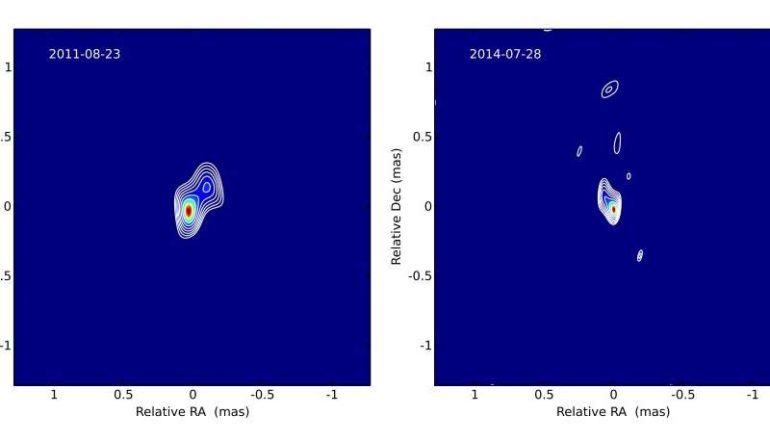Using the Very Long Baseline Array (VLBA), astronomers have performed high-resolution observations of the blazar PKS 1749+096. Results of this observational campaign, presented in a paper published October 23 on arXiv.org, provide essential information about the properties of the blazar’s inner jet.
Blazars are very compact quasars associated with supermassive black holes at the centers of active, giant elliptical galaxies. Based on their optical emission properties, astronomers divide blazars into two classes: flat-spectrum radio quasars (FSRQs) that feature prominent and broad optical emission lines, and BL Lacertae objects (BL Lacs), which do not.
In general, blazars belong to a larger group of active galaxies that host active galactic nuclei (AGN), and their characteristic features are relativistic jets pointed almost exactly toward the Earth. However, the detailed mechanisms of ejection and collimation of jets are still poorly understood, and more studies of this phenomenon are required to improve our knowledge on the subject.
At a redshift of 0.322, PKS 1749+096 is an ultra-luminous BL Lac object exhibiting strong variability from radio to X-rays. Previous observations have also identified unprecedented bright flaring activity in very high energy gamma-ray emission, together with X-ray and optical flares. Moreover, Very Long Baseline Interferometry (VLBI) studies of PKS 1749+096 have detected the existence of position angle swing exists in its jet.
In order to shed more light on the innermost region of the PKS 1749+096’s jet and its possible variations, a team of astronomers led by Lang Cui of the Xinjiang Astronomical Observatory in Urumqi, China, has conducted a detailed VLBA imaging study of this blazar with unprecedented resolution.
“In order to investigate the jet kinematics, in particular, the orientation of the inner jet on the smallest accessible scales and the basic physical conditions of the core, in this work, we adopted a super-resolution technique, the bi-spectrum maximum entropy method (BSMEM), to reanalyze VLBI images based on the Very Long Baseline Array (VLBA) observations of PKS 1749+096 within the VLBA-BU-BLAZAR 7mm monitoring program,” the researchers explained.
The observational campaign lasted from 2009 to 2019. The astronomers found that the VLBA stacked image of the blazar’s inner jet has a limb-brightened structure with apparent opening angles of 50 and 42 degrees at the distance of about 2.93 and 4.56 light years from the core. This corresponds to an intrinsic jet opening angle of 5.2 and 4.3 degrees, respectively.
Furthermore, the images of the jet position angle in PKS 1749+096 show a clear swing phenomenon within the last 10 years, when it was observed by VLBA. It was noted that the swing weakly correlates with the peak brightness.
However, the study found no correlation between the inner jet position angle and gamma-ray flux. According to the authors of the paper, this indicates that the gamma-ray emission in PKS 1749+096 is not sensitive to orientation-dependent effects. Summing up the results, the scientists emphasize the importance of future observations with more gamma-ray flux measurements, which would allow further investigation of their possible connection to the inner jet orientation.
Chinese astronomers investigate spectral behavior of gamma-ray blazar S5 0716+714
More information:
Cui et al., Resolving the inner jet of PKS 1749+096 with super-resolution VLBA images at 7 mm, arXiv:2010.12393 [astro-ph.HE] arxiv.org/abs/2010.12393
2020 Science X Network
Citation:
Inner jet of the blazar PKS 1749+096 investigated in detail (2020, November 2)
retrieved 2 November 2020
from https://phys.org/news/2020-11-jet-blazar-pks.html
This document is subject to copyright. Apart from any fair dealing for the purpose of private study or research, no
part may be reproduced without the written permission. The content is provided for information purposes only.


